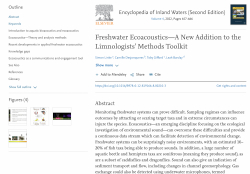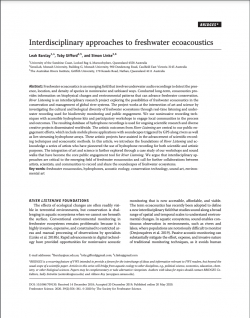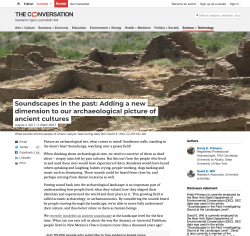Encyclopedia of Inland Waters (Second Edition) Freshwater Ecoacoustics—A New Addition to the Limnologists’ Methods Toolkit

Type
Journal
Authors
Linke ( Simon Linke )
Desjonqueres ( Camille Desjonqueres )
Gifford ( Toby Gifford )
Barclay ( Leah Barclay )
Category
Article
[ Browse Items ]
Publication Year
2022
Publisher
Elsevier, United States
URL
[ private ]
Volume
4
Pages
657-666
Series Name
Abstract
Monitoring freshwater systems can prove difficult. Sampling regimes can influence outcomes by attracting or scaring target taxa and in extreme circumstances can injure the species. Ecoacoustics—an emerging discipline focusing on the ecological investigation of environmental sound—can overcome these difficulties and provide a continuous data stream which can facilitate detection of environmental change. Freshwater systems can be surprisingly noisy environments, with an estimated 10–20% of fish taxa being able to produce sounds. In addition, a large number of aquatic beetle and hemiptera taxa are soniferous (meaning they produce sound), as are a subset of caddisflies and dragonflies. Sound can also give an indication of sediment transport and flow, including changes in channel geomorphology. Gas exchange could also be detected using underwater microphones, termed hydrophones. Finally, noise can be monitored, both as a proxy for other threats, but also as a direct driver of ecosystem stress.
In this chapter, we introduce the main sources of sounds in inland waters and a history of the research behind these. We discuss the concept of ecoacoustics—which relates to bioacoustics just like ecology relates to biology—and introduce analysis methods. We highlight current frontiers in ecoacoustic research, such as using AI to automatically classify and count sound events, analysis methods that detect change in entire soundscapes, and highlight theoretical concepts that can link sound to ecological conditions. Ecoacoustic research, especially in freshwater environments, has some key theoretical and technical knowledge gaps. These relate to spatial heterogeneity in underwater sounds, but also to large data volumes that are created by any soundscape applications. We close the chapter by discussing the use of and engagement with ecoacoustics in an art-science context.
In this chapter, we introduce the main sources of sounds in inland waters and a history of the research behind these. We discuss the concept of ecoacoustics—which relates to bioacoustics just like ecology relates to biology—and introduce analysis methods. We highlight current frontiers in ecoacoustic research, such as using AI to automatically classify and count sound events, analysis methods that detect change in entire soundscapes, and highlight theoretical concepts that can link sound to ecological conditions. Ecoacoustic research, especially in freshwater environments, has some key theoretical and technical knowledge gaps. These relate to spatial heterogeneity in underwater sounds, but also to large data volumes that are created by any soundscape applications. We close the chapter by discussing the use of and engagement with ecoacoustics in an art-science context.
Description
https://doi.org/10.1016/B978-0-12-819166-8.00210-3
Number of Copies
1
| Library | Accession No | Call No | Copy No | Edition | Location | Availability |
|---|---|---|---|---|---|---|
| Main | 607 | 1 | Yes |



